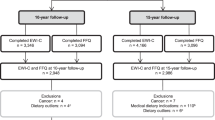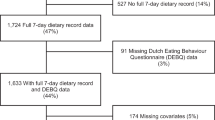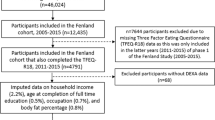Abstract
OBJECTIVE:
Unnecessary dietary restraint (ie in the absence of a need to lose weight) and chronic overeating are both very unhealthy activities. As a precursor to a more involved longitudinal study, we sought to identify potential early-life predictors that merit scrutiny in this context.
DESIGN:
Four retrospective questionnaire studies were conducted (Study 1, N=242; Study 2, N=297; Study 3, N=175; Study 4, N=261). Female participants (18–30 y) completed measures of current dietary restraint and overeating. They also recalled experiences between 5 and 10 years of age. All were staff or students at Loughborough University (UK).
RESULTS:
After considering obvious sources of systematic bias, we report evidence that (i) dietary restraint is related to memories of maternal weight and dietary behaviour, and (ii) overeating and meal-size selection are both associated with memories of receiving a high-energy diet.
CONCLUSION:
The role of maternal factors in dietary restraint is consistent with previous research exploring the early onset of this behaviour. However, the relationship between childhood diet and overeating has not been suggested elsewhere. This is particularly important because it suggests a previously unreported correspondence between childhood experience and behaviours associated with obesity in adulthood.
This is a preview of subscription content, access via your institution
Access options
Subscribe to this journal
Receive 12 print issues and online access
$259.00 per year
only $21.58 per issue
Buy this article
- Purchase on Springer Link
- Instant access to full article PDF
Prices may be subject to local taxes which are calculated during checkout

Similar content being viewed by others
References
Flegal KM, Carroll MD, Ogden CL, Johnson CL . Prevalence and trends in obesity among US adults, 1999–2000. JAMA 2002; 288: 1723–1727.
Wardle J, Johnson F . Weight and dieting: examining levels of weight concern in British adults. Int J Obes Relat Metab Disord 2002; 26: 1144–1149.
Laessle RG, Platte P, Schweiger U, Pirke, KM . Biological and psychological correlates of intermittent dieting behavior in young women: a model for bulimia nervosa. Physiol Behav 1996; 60: 1–5.
Rosen JC, Gross J, Vara L . Psychological adjustment of adolescents attempting to lose or gain weight. J Consult Clin Psychol 1987; 55: 742–747.
Kagan DM, Squires RL . Eating disorders among adolescents: patterns and prevalence. Adolescence 1984; 19: 207–211.
Polivy J, Herman CP, McFarlane T . Effects of anxiety on eating: does palatability moderate distress-induced overeating in dieters? J Abnorm Psychol 1984; 103: 505–510.
van Strien T, Frijters JER, Bergers GPA, Defares PB . The Dutch Eating Behaviour Questionnaire (DEBQ) for assessment of restrained, emotional, and external eating. Int J Eat Dis 1986; 5: 295–315.
Stunkard AJ, Messick S . The three-factor eating questionnaire to measure dietary restraint, disinhibition and hunger. J Psychosom Res 1985; 29: 71–83.
Heatherton TF, Herman CP, Polivy J, King GA, McGree ST . The (mis)measurement of restraint—an analysis of conceptual and psychometric issues. J Abnorm Psychol 1988; 97: 19–28.
Herman CP, Mack D . Restrained and unrestrained eating. J Pers 1975; 43: 647–660.
Westenhoefer J, Broeckmann P, Munch AK, Pudel V . Cognitive control of eating behavior and the disinhibition effect. Appetite 1994; 23: 27–41.
van Strien T, Cleven A, Shippers G . Restraint, tendency toward overeating ice cream consumption. Int J Eat Dis 2000; 28: 333–338.
Ouwens MA, van Strien T, van der Staak CPF . Tendency towards overeating and restraint as predictors of food consumption. Appetite 2003; 40: 291–298.
Hays NP, Bathalon GP, McCrory MA, Roubenoff R, Lipman R, Roberts SB . Eating behavior correlates of adult weight gain and obesity in healthy women aged 55–65 y. Am J Clin Nutr 2002; 75: 476–483.
Lawson OJ, Williamson DA, Champagne CM, Delany JP, Brooks ER, Howat PM, Wozniak PJ, Bray GA, Ryan DH . The association of body-weight, dietary-intake, and energy-expenditure with dietary restraint and disinhibition. Obes Res 1995; 3: 153–161.
Carper JL, Fisher JO, Birch LL . Young girls' emerging dietary restraint and disinhibition are related to parental control in child feeding. Appetite 2000; 35: 121–129.
Whitaker RC, Deeks CM, Baughcum AE, Specker BL . The relationship of childhood adiposity to parent body mass index and eating behavior. Obes Res 2000; 8: 234–240.
Abramovitz BA, Birch LL . Five-year-old girls' ideas about dieting are predicted by their mothers' dieting. J Am Diet Assoc 2000; 100: 1157–1163.
Davison KK, Markey CN, Birch LL . Etiology of body dissatisfaction and weight concerns among 5-year-old girls. Appetite 2000; 35: 143–151.
Fisher JO, Birch LL . Fat preferences and fat consumption of 3-year-old to 5-year-old children are related to parental adiposity. J Am Diet Assoc 1995; 95: 759–764.
Wardle J, Guthrie C, Sanderson S, Birch L, Plomin R . Food and activity preferences in children of lean and obese parents. Int J Obes Relat Metab Disord 2001; 25: 971–977.
Cutting TM, Fisher JO, Grimm-Thomas K, Birch LL . Like mother, like daughter: familial patterns of overweight are mediated by mothers' dietary disinhibition. Am J Clin Nutr 1999; 69: 608–613.
Hood MY, Moore LL, Sundarajan-Ramamurti A, Singer M, Cupples LA, Ellison RC . Parental eating attitudes and the development of obesity in children. The Framingham Children's Study. Int J Obes Relat Metab Disord 2000; 24: 1319–1325.
Costanzo PR, Woody EZ . Domain-specific parenting styles and their impact on the child's development of particular deviance: The example of obesity proneness. J Soc Clin Psychol 1985; 3: 425–445.
Johnson SL . Improving preschoolers’ self-regulation of energy intake. Pediatrics 2000; 106: 1429–1435.
Davison KK, Birch LL . Weight status, parent reaction, and self-concept in five-year-old girls. Pediatrics 2001; 107: 46–53.
Fisher JO, Birch LL . Restricting access to foods and children's eating. Appetite 1999; 32: 405–419.
Tiggemann M, Lowes J . Predictors of maternal control over children's eating behaviour. Appetite 2002; 39: 1–7.
Fisher JO, Birch LL . Eating in the absence of hunger and overweight in girls from 5 to 7 y of age. Am J Clin Nutr 2002; 76: 226–231.
Birch LL, Deysher M . Conditioned and unconditioned caloric compensation: evidence for self-regulation of food by young children. Learn Motiv 1985; 16: 341–355.
Birch LL, McPhee L, Shoba BC, Steinberg L, Krehbiel R . ‘Clean up your plate’. Effects of child feeding practices on the development of intake regulation. Learn Motiv 1987; 18: 301–317.
Baughcum AE, Burklow KA, Deeks CM, Powers SW, Whitaker RC . Maternal feeding practices and childhood obesity—a focus group study of low-income mothers. Arch Pediatr Adolesc Med 1998; 152: 1010–1014.
Birch LL, Zimmerman SI, Hind H . The influence of social-affective context on the formation of children's food preferences. J Nutr Educat 1981; 13: S115–S118.
Allison DA, Kalinsky LB, Gorman BS . A comparison of the psychometric properties of three measures of dietary restraint. Psychol Assess 1992; 4: 391–398.
MacCallum RC, Zhang SB, Preacher KJ, Rucker DD . On the practice of dichotomization of quantitative variables. Psychol Methods 2002; 7: 19–40.
Brewin CR, Andrews B, Gotlib IH . Psychopathology and early experience: a reappraisal of retrospective reports. Psychol Bull 1993; 113: 82–98.
Fivush R . Event memory in early childhood. In: Cowan N (ed) The Development of Memory in Childhood. Psychology Press: Hove; 1997. pp 139–161.
Cohen GM . Memory in the Real World, 2nd edn. Psychology Press: Hove; 1996.
Dube SR, Anda RF, Felitti VJ, Croft JB, Edwards VJ, Giles WH . Growing up with parental alcohol abuse: exposure to childhood abuse, neglect, and household dysfunction. Child Abuse Negl 2001; 25: 1627–1640.
Felitti VJ, Anda RF, Nordenberg D, Williamson DF, Spitz AM, Edwards V, Koss MP, Marks JS . Relationship of childhood abuse and household dysfunction to many of the leading causes of death in adults—the adverse childhood experiences (ACE) study. Am J Prev Med 1998; 14: 245–258.
Haug K, Irgens LM, Skjaerven R, Markestad T, Baste V, Schreuder P . Maternal smoking and birthweight: effect modification of period, maternal age and paternal smoking. Acta Obstet Gynecol Scand 2000; 79: 485–489.
Kardia SLR, Pomerleau CS, Rozek LS, Marks JL . Association of parental smoking history with nicotine dependence, smoking rate, and psychological cofactors in adult smokers. Addict Behav 2003; 28: 1447–1452.
Monden CWS, de Graaf ND, Kraaykamp G . How important are parents and partners for smoking cessation in adulthood? An event history analysis. Prev Med 2003; 36: 197–203.
Graeff TR . Uninformed response bias in telephone surveys. J Bus Res 2002; 55: 251–259.
Hawkins D, Coney KA . Uninformed response error in survey-research. J Market Res 1981; 18: 370–374.
Willett WC, Sampson L, Browne ML, Stampfer MJ, Rosner B, Hennekens CH, Speizer FE . The use of a self-administered questionnaire to assess diet 4 years in the past. Am J Epidemiol 1988; 127: 188–199.
Byers T, Marshall J, Anthony E, Fiedler R, Zielezny M . The reliability of dietary history from the distant past. Am J Epidemiol 1987; 125: 999–1011.
Thompson FE, Lamphiear DE, Metzner HL, Hawthorne VM, Oh MS . Reproducibility of reports of frequency of food use in the tecumseh diet methodology study. Am J Epidemiol 1987; 125: 658–671.
Friedenreich CM, Slimani N, Riboli E . Measurement of past diet—review of previous and proposed methods. Epidemiol Rev 1992; 14: 177–196.
Jensen ØM, Wahrendorf J, Rosenqvist A, Geser, A . The reliability of questionnaire-derived historical dietary information and temporal stability of food-habits in individuals. Am J Epidemiol 1984; 120: 281–290.
van Staveren WA, West CE, Hoffmans MDAF, Bos P, Kardinaal AFM, Van Poppel GAFC, Schipper HJA, Hautvast JGAJ, Hayes RB . Comparison of contemporaneous and retrospective estimates of food-consumption made by a dietary history method. Am J Epidemiol 1986; 123: 884–893.
Nelson M, Atkinson M, Meyer J . Food Portion Sizes: A Photographic Atlas. Food Standards Agency: UK; 1997.
Robinson F, Morritz W, McGuiness P, Hackett AF . A study of the use of a photographic food atlas to estimate served and self-served portion sizes. J Hum Nutr Diet 1997; 10: 117–124.
Ruderman AJ . Dietary restraint—a theoretical and empirical review. Psychol Bull 1986; 99: 247–262.
Johnson SL, McPhee L, Birch LL . Conditioned preferences: young children prefer flavors associated with high dietary fat. Physiol Behav 1991; 50: 1245–1251.
Birch LL, Fisher JO . Development of eating behaviors among children and adolescents. Pediatrics 1998; 101: 539–549.
Klajner F, Herman CP, Polivy J, Chhabra R . Human obesity, dieting, and anticipatory salivation to food. Physiol Behav 1981; 27: 195–198.
LeGoff DB, Spigelman MN . Salivary response to olfactory food stimuli as a function of dietary restraint and body-weight. Appetite 1987; 8: 29–35.
Laessle RG, Tuschl RJ, Kotthaus BC, Pirke KM . A comparison of the validity of three scales for the assessment of dietary restraint. J Abnorm Psychol 1989; 98: 504–507.
Wardle J . Dietary restraint and binge eating. Behav Analysis Modif 1980; 4: 201–209.
Fedoroff IC, Polivy J, Herman CP . The effect of pre-exposure to food cues on the eating behaviour of restrained and unrestrained eaters. Appetite 1997; 28: 33–47.
Fedoroff IC, Polivy J, Herman CP . The specificity of restrained versus unrestrained eaters’ responses to food cues: general desire to eat, or craving for the cued food? Appetite 2003; 41: 7–13.
Krassner HA, Brownell KD, Stunkard AJ . Cleaning the plate: food left over by overweight and normal weight persons. Behav Res Ther 1979; 17: 155–156.
Diliberti N, Bordi PL, Conklin MT, Rolls BJ . Increasing the portion size of a restaurant entrée results in increased food intake. FASEB J 2003; 17: A809.
Nielsen SJ, Popkin BM . Patterns and trends in food portion sizes, 1977–1998. J Am Med Assoc 2003; 289: 450–453.
Rolls BJ . The supersizing of America: portion size and the obesity epidemic. Nutr Today 2003; 38: 42–53.
Smiciklas-Wright H, Mitchell DC, Mickle SJ, Goldman JD, Cook A . Foods commonly eaten in the United States, 1989–1991 and 1994–1996: are portion sizes changing? J Am Diet Assoc 2003; 103: 41–47.
Young LR, Nestle M . The contribution of expanding portion sizes to the US obesity epidemic. Am J Public Health 2002; 92: 246–249.
Rolls BJ, Roe LS, Kral TVE, Meengs JS, Wall DE . Increasing the portion size of a packaged snack increases energy intake in men and women. Appetite 2004; 42: 63–69.
Rolls BJ, Engell D, Birch LL . Serving portion size influences 5-year-old but not 3-year old children's food intakes. J Am Diet Assoc 2000; 100: 232–234.
Boreham C, Riddoch, C . The physical activity, fitness and health of children. J Sports Sci 2001; 19: 915–929.
Halvarsson M, Lunner K, Westerberg J, Anteson F, Sjödén P-O . A longitudinal study of the development of dieting among 7–17-year-old Swedish girls. Int J Eat Dis 2002; 31: 32–42.
Huon GF, Walton C . Initiation of dieting among adolescent females. Int J Eat Dis 2000; 28: 226–230.
Hill AJ . Developmental issues in attitudes to food and diet. Proc Nutr Soc 2002; 61: 259–266.
Branson R, Potoczna N, Kral JG, Lentes K, Hoehe MR, Horber FF . Binge eating as a major phenotype of melanocortin 4 receptor gene mutations. N Engl J Med 2003; 348: 1096–1103.
Rutherford J, McGuffin P, Katz RJ, Murray RM . Genetic influences on eating attitudes in a normal female twin population. Psychol Med 1993; 23: 425–436.
Neale BM, Mazzeo SE, Bulik CM . A twin study of dietary restraint, disinhibition and hunger: An examination of the eating inventory (three factor eating questionnaire). Twin Res 2003; 6: 471–478.
Steinle NI, Hsueh WC, Snitker S, Pollin TI, Sakul H, St Jean PL, Bell CJ, Mitchell BD, Shuldiner AR . Eating behavior in the Old Order Amish: heritability analysis and a genome-wide linkage analysis. Am J Clin Nutr 2002; 75: 1098–1106.
Acknowledgements
We would like to express our gratitude to Paul Lattimore, Michael Lowe, and Kevin Morgan for their comments on earlier drafts of this manuscript. This work was funded by a BBSRC grant (reference: D15238).
Author information
Authors and Affiliations
Corresponding author
Rights and permissions
About this article
Cite this article
Brunstrom, J., Mitchell, G. & Baguley, T. Potential early-life predictors of dietary behaviour in adulthood: a retrospective study. Int J Obes 29, 463–474 (2005). https://doi.org/10.1038/sj.ijo.0802890
Received:
Revised:
Accepted:
Published:
Issue Date:
DOI: https://doi.org/10.1038/sj.ijo.0802890
Keywords
This article is cited by
-
Caregiver Influences on Eating Behaviors in Children: An Opportunity for Preventing Obesity
Current Atherosclerosis Reports (2023)
-
On the measurement and correlates of plate clearing: examining a German version of the Plate Clearing Tendency Scale
Eating and Weight Disorders - Studies on Anorexia, Bulimia and Obesity (2022)
-
Physical activity and screen time in out of school hours care: an observational study
BMC Pediatrics (2019)
-
Empty plates and larger waists: a cross-sectional study of factors associated with plate clearing habits and body weight
European Journal of Clinical Nutrition (2016)
-
Longitudinal Association of Maternal Attempt to Lose Weight During the Postpartum Period and Child Obesity at Age 3 Years
Obesity (2011)



